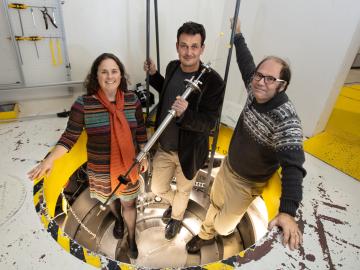
Filter News
Area of Research
- (-) Functional Materials for Energy (1)
- (-) Fusion Energy (15)
- (-) Neutron Science (36)
- (-) Supercomputing (52)
- Advanced Manufacturing (22)
- Biology and Environment (30)
- Building Technologies (1)
- Computational Engineering (2)
- Computer Science (7)
- Electricity and Smart Grid (3)
- Energy Science (135)
- Fusion and Fission (30)
- Isotope Development and Production (1)
- Isotopes (2)
- Materials (125)
- Materials Characterization (1)
- Materials for Computing (16)
- Materials Under Extremes (1)
- Mathematics (1)
- National Security (17)
- Nuclear Science and Technology (15)
- Quantum information Science (1)
- Sensors and Controls (1)
- Transportation Systems (1)
News Topics
- (-) 3-D Printing/Advanced Manufacturing (11)
- (-) Big Data (23)
- (-) Fusion (16)
- (-) Grid (5)
- (-) Materials Science (35)
- (-) Mathematics (2)
- (-) Physics (17)
- Advanced Reactors (9)
- Artificial Intelligence (40)
- Bioenergy (14)
- Biology (16)
- Biomedical (28)
- Biotechnology (2)
- Buildings (4)
- Chemical Sciences (7)
- Clean Water (2)
- Composites (1)
- Computer Science (100)
- Coronavirus (19)
- Critical Materials (3)
- Cybersecurity (9)
- Energy Storage (15)
- Environment (29)
- Exascale Computing (26)
- Fossil Energy (1)
- Frontier (33)
- High-Performance Computing (44)
- Hydropower (1)
- Isotopes (2)
- Machine Learning (17)
- Materials (30)
- Microscopy (8)
- Molten Salt (1)
- Nanotechnology (19)
- National Security (8)
- Neutron Science (122)
- Nuclear Energy (17)
- Partnerships (1)
- Polymers (3)
- Quantum Computing (20)
- Quantum Science (30)
- Security (7)
- Simulation (16)
- Software (1)
- Space Exploration (5)
- Summit (43)
- Transportation (10)
Media Contacts

Scientists at have experimentally demonstrated a novel cryogenic, or low temperature, memory cell circuit design based on coupled arrays of Josephson junctions, a technology that may be faster and more energy efficient than existing memory devices.

Researchers across the scientific spectrum crave data, as it is essential to understanding the natural world and, by extension, accelerating scientific progress.

For nearly three decades, scientists and engineers across the globe have worked on the Square Kilometre Array (SKA), a project focused on designing and building the world’s largest radio telescope. Although the SKA will collect enormous amounts of precise astronomical data in record time, scientific breakthroughs will only be possible with systems able to efficiently process that data.

As scientists study approaches to best sustain a fusion reactor, a team led by Oak Ridge National Laboratory investigated injecting shattered argon pellets into a super-hot plasma, when needed, to protect the reactor’s interior wall from high-energy runaway electrons.

Kathy McCarthy has been named director of the US ITER Project Office at the Department of Energy’s Oak Ridge National Laboratory, effective March 2020.

Scientists at the U.S. Department of Energy’s Brookhaven National Laboratory have new experimental evidence and a predictive theory that solves a long-standing materials science mystery: why certain crystalline materials shrink when heated.

Researchers at the Department of Energy’s Oak Ridge National Laboratory have received five 2019 R&D 100 Awards, increasing the lab’s total to 221 since the award’s inception in 1963.

The U.S. Department of Energy announced funding for 12 projects with private industry to enable collaboration with DOE national laboratories on overcoming challenges in fusion energy development.

In collaboration with the Department of Veterans Affairs, a team at Oak Ridge National Laboratory has expanded a VA-developed predictive computing model to identify veterans at risk of suicide and sped it up to run 300 times faster, a gain that could profoundly affect the VA’s ability to reach susceptible veterans quickly.

More than 6,000 veterans died by suicide in 2016, and from 2005 to 2016, the rate of veteran suicides in the United States increased by more than 25 percent.


